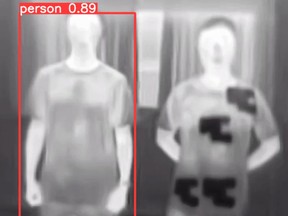Chinese students develop 'invisibility cloak' to hide from AI security cameras
Chinese police have been known to use facial recognition technology to track dissidents, ethnic minorities and migrant workers

Article content
Four graduate students from the University of Wuhan in China have invented a low-cost “invisibility cloak” that hides the human body from AI-monitored security cameras, concealing the identity of the individual wearing it.
Article content
By day, the InvisiDefense coat resembles a regular camouflage garment but has a customized pattern designed by an algorithm that blinds the camera. By night, the coat’s embedded thermal device emits varying heat temperatures — creating an unusual heat pattern — to fool security cameras that use infrared thermal imaging.
Article content
“Nowadays, many surveillance devices can detect human bodies,” said Professor Wang Zheng who oversaw the project.

“Cameras on the road have pedestrian detection functions and smart cars can identify pedestrians, roads and obstacles. Our InvisDefense allows the camera to capture you, but it cannot tell if you are human,” he said in the report.
Article content
In their preliminary trials, the students tested the coat on campus security cameras in an attempt to evade recognition. Results showed a 57 per cent reduction in the accuracy of pedestrian detection. The challenge, they said, was developing a coat that fooled both the human eye and cameras.
“We had to use an algorithm to design a least conspicuous image that could render camera vision ineffective,” Wei Hui, the computer science graduate student who designed the coat’s algorithm, told Vice News.
China’s techno-tyranny possesses some of the world’s most advanced surveillance systems, with millions of cameras on street corners and at the entrance of buildings. The police use it to track dissidents, ethnic minorities and migrant workers.
Article content
During China’s recent wave of anti-lockdown protests, many were arrested using facial recognition technology.
“China’s ‘Big Brother’ technology is never switched off, and the government hopes it will now show its effectiveness in snuffing out unrest,” Alkan Akad, a China researcher at Amnesty International, told The New York Times.
Many countries have laws to protect its citizens from being surveilled using facial recognition technology.
In 2020, the Royal Canadian Mounted Police faced public outcry when they had announced their use of Clearview AI software despite having previously denied it. The company’s algorithm matches faces to a database of more than 20 billion images indexed from the internet, including social media applications.
Article content
The facial recognition software was used in 15 child sexual exploitation cases, and said other units were using it on a “trial basis” to “determine its utility to enhance criminal investigations.”
Clearview AI halted its services in Canada and suspended its contract with the RCMP in July 2020, in response to a joint federal-provincial privacy investigation.
In February 2021, Canada’s federal privacy watchdog declared that “what Clearview does is mass surveillance, and it is illegal.”
According to an October report released by MPs, Canada’s current legislation doesn’t adequately regulate facial recognition or artificial intelligence technologies.
“Since such a legislative framework does not exist at the time a national pause should be imposed on the use of FRT, particularly with respect to police services,” the report said.
‘Invisibility cloak’ that hides wearers
from security cameras invented by students in Wuhan
Thu, December 8, 2022
Students in China have invented an “invisibility cloak” designed to hide wearers from security cameras.
The InvisDefense, developed by a team at Wuhan University, is a low-cost coat that can be used day or night to evade detection from security camera systems monitored by artificial intelligence.
During the day, the coat uses a pattern to effectively blind the cameras, while at night it emits unusual heat signals to confuse infrared cameras.
The coat appears ordinary to human eyes and is ineffective at hiding wearers from human-monitored security cameras. Its design means it would also potentially confuse some of the detection systems used in self-driving cars, but not the human drivers.
“Nowadays, many surveillance devices can detect human bodies,” Professor Wang Zheng from Wuhan University’s school of computer science, who oversaw the invention, told the South China Morning Post.
“Cameras on the road have pedestrian detection functions and smart cars can identify pedestrians, roads and obstacles. Our Invisdefense allows the camera to capture you, but it cannot tell if you are human.”
The coat won first prize in a contest sponsored by Huawei Technologies, with a paper describing the technology set to be presented at the AAAI 2023 AI conference in the US in February.
Wuhan University PhD student Wei Hui, who created the algorithm that generated the coat’s pattern, estimated that it costs less than 500 yuan (£59) to make the InvisDefense.
“The most difficult part is the balance of the camouflage pattern. Traditionally, researchers used bright images to interfere with machine vision and it did work,” said Wei Hui.
“But it stands out to human eyes, making the user even more conspicuous. We use algorithms to design the least conspicuous patterns that can disable computer vision.”
Professor Wang said the coat could be used for stealth military uniforms to evade detection from drones, or AI-controlled units on the battlefield.
Researchers could also potentially use the pattern-generating algorithm to better understand and patch up loopholes in artificial intelligence and computer recognition technology.



No comments:
Post a Comment
Comments always welcome!